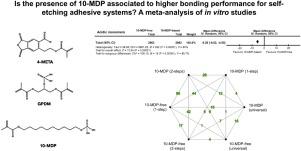Dental Materials ( IF 5 ) Pub Date : 2021-08-26 , DOI: 10.1016/j.dental.2021.08.014 Julia Fehrenbach 1 , Cristina Pereira Isolan 2 , Eliseu Aldrighi Münchow 3

|
Objective
The purpose of this systematic review and meta-analysis was to analyze the literature on the bond strength of self-etching (SE) adhesives containing 10-MDP or other acidic functional monomers, comparing the bonding performance of both compositions.
Methods
This study is registered in PROSPERO (CRD42020175715) and it followed the PRISMA Statement. The literature search was performed in PubMed, Web of Science, SciELO, Scopus, LILACS, IBECS, and BBO from the starting coverage date through 30 June 2021. Study eligibility criteria consisted of in vitro studies that evaluated the bond strength (microtensile, microshear, tensile or shear testing) to sound dentin/enamel of a minimum of two distinct SE systems, with at least one material containing 10-MDP and one other being comprised of a distinct acidic composition. Statistical analyses were carried out with RevMan 5.3.5 and using random-effects models with the significance level at p < 0.05. Also, Bayesian network meta-analysis (NMA) was conducted using MetaInsight V3 tool.
Results
From 740 relevant studies evaluated in full-text analysis, 210 were incorporated to the systematic review and 206 in meta-analysis. The majority of studies was classified as having medium risk of bias (56.7%), followed by low (35.2%) and high (8.1%) risk of bias. Data from a total of 64 adhesive systems were collected, which favored the 10-MDP-based group at both dentin (overall effect: 6.98; 95% CI: 5.61, 8.36; p < 0.00001) and enamel (overall effect: 2.79; 95% CI: 1.62, 3.96; p < 0.00001) substrates. Microtensile testing was more frequently used (73.4%) in the included studies. Adhesives based on 10-MDP showed greater bonding performance than adhesives comprised of monomers such as PENTA, 6-MHP, 4-META, 4-MET, pyrophosphate esters, mixed composition or monomers derived from sulfonic acid (p ≤ 0.01); whereas similar bond strength values were verified between 10-MDP-based materials and those containing PEM-F, acrylamide phosphates, 4-AET, MAC-10, or monomers derived from polyacrylic and phosphonic acids (p ≥ 0.05). Adhesives based on GPDM were the only ones that resulted in greater bonding potential than the 10-MDP-based group (p = 0.03). Dental bonds in dentin were favored with the application of 2-step 10-MDP-based adhesives; whereas in enamel the dental bonds were favored for both 2-steps versions of adhesives, regardless of the presence of 10-MDP. Indirect evidence from NMA revealed that 1-step 10-MDP-free and universal 10-MDP-free adhesives seemed to perform worst in dentin and enamel, respectively.
Significance
Adhesives containing 10-MDP showed higher bonding performance than materials formulated with other acidic ingredients, although this result relied on the type of mechanical testing, type of the substrate, acidic composition of the adhesive, and the application category of the SE system. This review summarized the effects of the foregoing factors on the adhesion to dental substrates.
中文翻译:

10-MDP 的存在是否与自酸蚀粘合剂系统的更高粘合性能有关?体外研究的荟萃分析
客观的
本系统综述和荟萃分析的目的是分析关于含有 10-MDP 或其他酸性官能单体的自酸蚀 (SE) 粘合剂粘合强度的文献,比较两种组合物的粘合性能。
方法
本研究在 PROSPERO (CRD42020175715) 中注册,并遵循 PRISMA 声明。包括通过6月30日2021年的研究资格标准考研,科学,SciELO,SCOPUS,紫丁香,IBECS的Web和BBO进行文献检索从起始日期覆盖在体外研究,评估的粘结强度(微拉伸,微剪切,拉伸或剪切测试)以检测至少两种不同 SE 系统的健全牙本质/牙釉质,其中至少一种材料含有 10-MDP,另一种材料由不同的酸性成分组成。使用 RevMan 5.3.5 并使用显着性水平为 p < 0.05 的随机效应模型进行统计分析。此外,贝叶斯网络元分析 (NMA) 是使用 MetaInsight V3 工具进行的。
结果
在全文分析中评估的 740 项相关研究中,210 项被纳入系统评价,206 项被纳入荟萃分析。大多数研究被归类为具有中等偏倚风险 (56.7%),其次是低 (35.2%) 和高 (8.1%) 偏倚风险。收集了来自总共 64 个粘合剂系统的数据,这些数据在牙本质(总体效果:6.98;95% CI:5.61、8.36;p < 0.00001)和牙釉质(总体效果:2.79;95 % CI:1.62, 3.96;p < 0.00001) 底物。在纳入的研究中,微拉伸试验的使用频率更高(73.4%)。基于 10-MDP 的粘合剂比由单体如 PENTA、6-MHP、4-META、4-MET、焦磷酸酯、混合组合物或磺酸衍生的单体组成的粘合剂表现出更好的粘合性能(p ≤ 0.01);而基于 10-MDP 的材料与含有 PEM-F、丙烯酰胺磷酸盐、4-AET、MAC-10 或衍生自聚丙烯酸和膦酸的单体的材料之间的粘合强度值相似(p ≥ 0.05)。与基于 10-MDP 的组相比,基于 GPDM 的粘合剂是唯一导致粘合潜力更大的粘合剂(p = 0.03)。使用基于 2 步 10-MDP 的粘合剂有利于牙本质中的牙齿粘合;而在牙釉质中,无论 10-MDP 是否存在,两种 2 步版本的粘合剂都有利于牙齿粘合。来自 NMA 的间接证据表明,1 步无 10-MDP 和通用无 10-MDP 粘合剂似乎分别在牙本质和牙釉质中表现最差。或衍生自聚丙烯酸和膦酸的单体 (p ≥ 0.05)。与基于 10-MDP 的组相比,基于 GPDM 的粘合剂是唯一导致粘合潜力更大的粘合剂(p = 0.03)。使用基于 2 步 10-MDP 的粘合剂有利于牙本质中的牙齿粘合;而在牙釉质中,无论 10-MDP 是否存在,两种 2 步版本的粘合剂都有利于牙齿粘合。来自 NMA 的间接证据表明,1 步无 10-MDP 和通用无 10-MDP 粘合剂似乎分别在牙本质和牙釉质中表现最差。或衍生自聚丙烯酸和膦酸的单体 (p ≥ 0.05)。与基于 10-MDP 的组相比,基于 GPDM 的粘合剂是唯一导致粘合潜力更大的粘合剂(p = 0.03)。使用基于 2 步 10-MDP 的粘合剂有利于牙本质中的牙齿粘合;而在牙釉质中,无论 10-MDP 是否存在,两种 2 步版本的粘合剂都有利于牙齿粘合。来自 NMA 的间接证据表明,1 步无 10-MDP 和通用无 10-MDP 粘合剂似乎分别在牙本质和牙釉质中表现最差。而在牙釉质中,无论 10-MDP 是否存在,两种 2 步版本的粘合剂都有利于牙齿粘合。来自 NMA 的间接证据表明,1 步无 10-MDP 和通用无 10-MDP 粘合剂似乎分别在牙本质和牙釉质中表现最差。而在牙釉质中,无论 10-MDP 是否存在,两种 2 步版本的粘合剂都有利于牙齿粘合。来自 NMA 的间接证据表明,1 步无 10-MDP 和通用无 10-MDP 粘合剂似乎分别在牙本质和牙釉质中表现最差。
意义
含有 10-MDP 的粘合剂表现出比用其他酸性成分配制的材料更高的粘合性能,尽管这一结果取决于机械测试的类型、基材的类型、粘合剂的酸性成分以及 SE 系统的应用类别。本综述总结了上述因素对牙科基材附着力的影响。



























 京公网安备 11010802027423号
京公网安备 11010802027423号